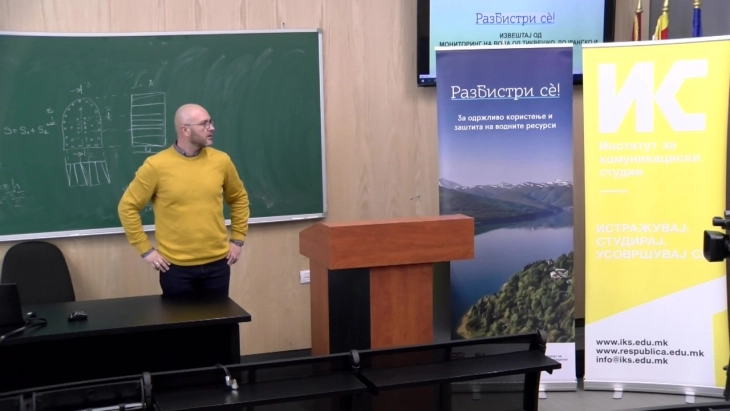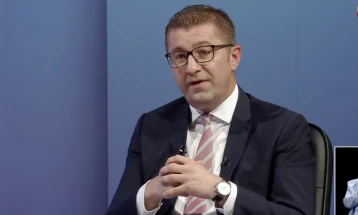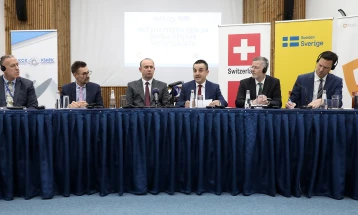Dojran, Tikvesh and Berovo Lakes "highly eutrophic and polluted": monitoring report

Shtip, 23 December 2021 (MIA) - The waters of Dojran, Tikvesh and Berovo Lakes are classified as Class 4, which refers to highly eutrophic, polluted water, meaning in its natural state can be used for other purposes only after certain methods of treatment have been implemented, shows a water quality monitoring conducted by Goce Delchev Univerity in Shtip in cooperation with the Institute of Communication Studies as part of the “Clear it Up” campaign.
The monitoring was conducted from April to November this year, to determine water quality in Dojran, Tikvesh and Berovo Lakes, which are used for various purposes – tourism and recreation, irrigation and water supply, and it was done in two seasons of the year – in the spring, when the lakes are filled with water and in autumn, when the level of all lakes is at its lowest.
According to the microbiological analyses, coliform bacteria of faecal origin were detected in Dojran and Tikvesh Lakes, which classify the lakes as Classes 3 and 4.
“Class 3 microbiological pollution means that the water can be used for irrigation, and after processing it can also be used in industries that do not require drinking water quality, while Class 4 pollution does not allow this water to be used for recreational purposes. Local faecal contamination is also indicated by nitrite concentrations that vary during the spring and autumn seasons in all three lakes, so there are occasional concentrations that categorise the waters as Class 3-4. Nitrite is very toxic to fish and all living organisms,” said a press release of the Clear It Up campaign.
In Berovo and Tikvesh Lakes, in autumn, the concentrations of total phosphorus significantly increase and reach Class 4. This indicates possible water pollution in these lakes due to excessive use of fertilizers in agriculture, untreated water from the public water system and discharges from farms or treatment plants. Measurable concentrations of total phosphorus have not been detected in Lake Dojran, said professor Gjorgi Dimov.
When it comes to dissolved metals in the waters, in Lake Dojran, he said, copper concentrations show amounts that exceed the limits in certain samples in the spring and autumn measurements and are categorized as Class 3-4. In the measurements conducted in autumn, an excess of iron was also detected. Slightly increased concentrations of lead and significantly increased concentrations of cadmium were detected in Lake Tikvesh in autumn. Chronic exposure to cadmium can lead to major adverse effects on aquatic organisms and therefore further research is needed to determine the source of this toxic metal.
According to the chemical consumption of oxygen in the water, which is also an indicator of water pollution, Lake Dojran reaches Class 3, while the waters of Lake Tikvesh and Lake Berovo are classified as Class 2. The increased chemical consumption of oxygen in Lake Dojran and Lake Tikvesh is due to high levels of decomposing plant matter, and the situation is aggravated by inflow of public and industrial wastewater, while in Berovo Lake, in autumn, it is due to the enormous decrease of the lake’s water level.
Given the indications of occasionally high levels of water pollution in Dojran, Tikvesh and Berovo Lakes, additional and continuous analysis of all indicators of lake water quality is necessary, especially eutrophication and the oxygen regime, which will give a clearer picture of potential sources of pollution and measures to improve water quality in lakes, according to the report.
The waters in these lakes are classified according to the rule that the lowest class determined for a certain indicator, such as microbiological pollution, nutrients that are parameters of eutrophication and oxygen regime, determines the general class of the water body. According to the purpose and degree of purity of the waters, they are assigned to 5 classes, as follows: Class 1 – very clean, oligotrophic water, Class 2 – slightly polluted, mesotrophic water, Class 3 – moderately eutrophic water, Class 4 – highly eutrophic, polluted water, and Class 5 – highly polluted, hypertrophic water.
The monitoring report and the chemical analyses were performed by the AMBIKON Laboratory at the Goce Delchev University and the microbiological analyses were made in the Shtip Public Health Centre.







